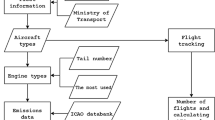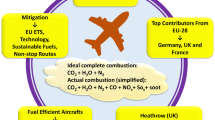Abstract
In the last decade, aircraft-induced environmental issues have attracted much research interest. In addition to studies on performance related emissions, air pollution and emissions in the field of airports also draw attention. Within this framework, the Antalya International Airport, one of the busiest airports in Turkey, is assessed from the viewpoint of the environment and economics. The present paper reveals the environmental impact and environmental cost of emitted exhaust gases from aircraft operating at the Antalya International Airport in July, 2018, the busiest period in the year. Within this scope the emissions indexes of each exhaust gas, global warming potential and environmental cost of various aircraft types and airways are calculated. To determine these parameters, real-time measurement data has been obtained from the Ministry of Transport and Infrastructure of the Republic of Turkey. At the end of the analyses, aircraft of the B737 family are found to have the highest global warming potential and environmental cost, with values of 630,633.3 GWP and 39,723.4 Euros, respectively. In a future study, the authors intend to evaluate particulate matter emissions at the same airport.















Similar content being viewed by others
Availability of data and materials
The data that support the findings of this study are available from the Transport and Infrastructure Ministry of Republic of Turkey but restrictions apply to the availability of these data, which were used under license for the current study and so are not publicly available. Data are however available from the authors upon reasonable request and with permission of the Transport and Infrastructure Ministry of Republic of Turkey.
References
Arvin MB, Pradhan RP, Norman NR (2015) Transportation intensity, urbanization, economic growth, and CO2 emissions in the G-20 countries. Util Policy 35:50–66
Edwards HA, Dixon-Hardy D, Wadud Z (2016) Aircraft cost index and the future of carbon emissions from air travel. Appl Energy 164:553–562
Evertse C, Visser HG (2017) Real-time airport surface movement planning: minimizing aircraft emissions. Transport Res Part C: Emerging Technologies 79:224–241
Fan W, Sun Y, Zhu T, Wen Y (2012) Emissions of HC, CO, NOx, CO2, and SO2 from civil aviation in China in 2010. Atmos Environ 56:52–57
Grote M, Williams I, Preston J (2014) Direct carbon dioxide emissions from civil aircraft. Atmos Environ 95:214–224
Gürkan H, Gürel S, Aktürk MS (2016) An integrated approach for airline scheduling, aircraft fleeting and routing with cruise speed control. Transport Res Part C: Emerging Technologies 68:38–57
Howitt OJ, Carruthers MA, Smith IJ, Rodger CJ (2011) Carbon dioxide emissions from international air freight. Atmos Environ 45(39):7036–7045
IPCC (2018) Global Warming of 1. 5°C. An IPCC Special Report on the impacts of global warming of 1.5°C above pre-industrial levels and related global greenhouse gas emission pathways, in the context of strengthening the global response to the threat of climate change, sustainable development, and efforts to eradicate poverty
Johnson GR, Mazaheri M, Ristovski ZD, Morawska L (2008) A plume capture technique for the remote characterization of aircraft engine emissions. Environ Sci Technol 42(13):4850–4856
Klapmeyer ME, Marr LC (2012) CO2, NOx, and particle emissions from aircraft and support activities at a regional airport. Environ Sci Technol 46(20):10974–10981
Kousoulidou M, Lonza L (2016) Biofuels in aviation: Fuel demand and CO2 emissions evolution in Europe toward 2030. Transp Res Part D: Transp Environ 46:166–181
Kurniawan JS, Khardi S (2011) Comparison of methodologies estimating emissions of aircraft pollutants, environmental impact assessment around airports. Environ Impact Assess Rev 31(3):240–252
Loo BP, Li L, Psaraki V, Pagoni I (2014) CO2 emissions associated with hubbing activities in air transport: an international comparison. J Transp Geogr 34:185–193
Mahashabde A, Wolfe P, Ashok A, Dorbian C, He Q, Fan A et al (2011) Assessing the environmental impacts of aircraft noise and emissions. Prog Aerosp Sci 47(1):15–52
Malavolti E, Podesta M (2015) Strategic reactions of airlines to the European trading scheme. Transport Res Proc 8:103–113
Manigandan S, Atabani AE, Ponnusamy VK, Pugazhendhi A, Gunasekar P, Prakash S (2020a) Effect of hydrogen and multiwall carbon nanotubes blends on combustion performance and emission of diesel engine using Taguchi approach. Fuel 276:118120
Manigandan S, Atabani AE, Ponnusamy VK, Gunasekar P (2020b) Impact of additives in Jet-A fuel blends on combustion, emission and exergetic analysis using a micro-gas turbine engine. Fuel 276:118104
Manigandan S, Ponnusamy VK, Devi PB, Oke SA, Sohret Y, Venkatesh S, Vimal MR, Gunasekar P (2020c) Effect of nanoparticles and hydrogen on combustion performance and exhaust emission of corn blended biodiesel in compression ignition engine with advanced timing. Int J Hydrog Energy 45(4):3327–3339
Manigandan S, Sarweswaran R, Devi PB, Sohret Y, Kondratiev A, Venkatesh S et al (2020d) Comparative study of nanoadditives TiO2, CNT, Al2O3, CuO and CeO2 on reduction of diesel engine emission operating on hydrogen fuel blends. Fuel 262:116336
Meyer L, Tsatsaronis G, Buchgeister J, Schebek L (2009) Exergoenvironmental analysis for evaluation of the environmental impact of energy conversion systems. Energy 34(1):75–89
Schürmann G, Schäfer K, Jahn C, Hoffmann H, Bauerfeind M, Fleuti E, Rappenglück B (2007) The impact of NOx, CO and VOC emissions on the air quality of Zurich airport. Atmos Environ 41(1):103–118
Scotti D, Volta N (2015) An empirical assessment of the CO2-sensitive productivity of European airlines from 2000 to 2010. Transp Res Part D: Transp Environ 37:137–149
Sohret Y (2019) Multi-objective evaluation of aviation-induced GHG emissions: UK domestic flight pattern. Energy Environ 30(6):1049–1064
Sohret Y, Gurbuz H (2021) A comparison of gasoline, liquid petroleum gas and hydrogen utilization in an SI engine in terms of environmental and economic indicators. J Energy Resourc Technol 143(5):052301
Song SK, Shon ZH (2012) Emissions of greenhouse gases and air pollutants from commercial aircraft at international airports in Korea. Atmos Environ 61:148–158
The World Bank (2019) World development indicators: air transport, passengers carried. https://databank.worldbank.org/reports.aspx?source=2&type=metadata&series=IS.AIR.PSGR. Accessed 02 Jan 2020
Turkish Statistical Institute (2019) Total passenger and freight traffic at airports. http://www.tuik.gov.tr/PreIstatistikTablo.do?istab_id=1051. Accessed 02 Jan 2020
Van Pham V, Tang J, Alam S, Lokan C, Abbass HA (2010) Aviation emission inventory development and analysis. Environ Model Softw 25(12):1738–1753
Vogtlander J (2019). Data on eco-costs. Delft University of Technology.
Vogtlander J, Bijma A (2000) The ‘Virtual Pollution Prevention Costs ‘99’. Int J Life Cycle Assess 5(2):113–120
Winther M, Kousgaard U, Oxbøl A (2006) Calculation of odour emissions from aircraft engines at Copenhagen Airport. Sci Total Environ 366(1):218–232
Zhang W, Jiang L, Cui Y, Xu Y, Wang C, Yu J, Streets DG, Lin B (2019) Effects of urbanization on airport CO2 emissions: a geographically weighted approach using nighttime light data in China. Resour Conserv Recycl 150:104454
Zhu Y, Fanning E, Yu RC, Zhang Q, Froines JR (2011) Aircraft emissions and local air quality impacts from takeoff activities at a large international airport. Atmos Environ 45(36):6526–6533
Acknowledgments
The authors thank the Ministry of Transport and Infrastructure of the Republic of Turkey for the permission to use the data in the analyses.
Author information
Authors and Affiliations
Contributions
Selçuk Ekici is responsible for the methodology, writing, reviewing and editing, as well as validation. Yasin Şöhret is responsible for the supervision, conceptualization, writing, reviewing, and editing, as well as validation.
Corresponding author
Ethics declarations
Competing interests
The authors declare that they have no competing interests.
Ethical approval
Not applicable.
Consent to participate
The authors consent to participate in this research study.
Consent to publish
The authors consent to publish the current research in the Environmental Science and Pollution Research journal.
Additional information
Responsible Editor: Philippe Garrigues
Publisher’s note
Springer Nature remains neutral with regard to jurisdictional claims in published maps and institutional affiliations.
Rights and permissions
About this article
Cite this article
Ekici, S., Şöhret, Y. A study on the environmental and economic aspects of aircraft emissions at the Antalya International Airport. Environ Sci Pollut Res 28, 10847–10859 (2021). https://doi.org/10.1007/s11356-020-11306-w
Received:
Accepted:
Published:
Issue Date:
DOI: https://doi.org/10.1007/s11356-020-11306-w




